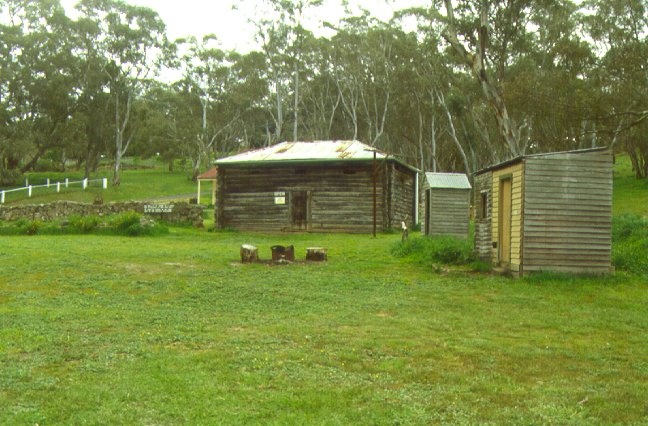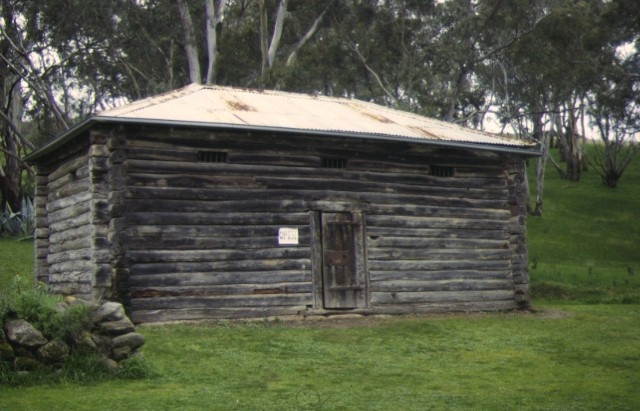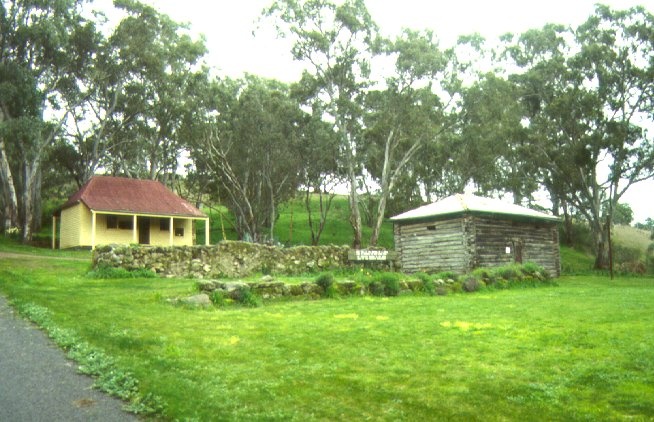FORMER LOG LOCK-UP
2-6 BLAIR STREET HARROW, WEST WIMMERA SHIRE
-
Add to tour
You must log in to do that.
-
Share
-
Shortlist place
You must log in to do that.
- Download report








Statement of Significance
What is significant?
The Log Lock-up at Harrow was erected under the supervision of the Public Works Department and was built in 1859 by a Melbourne contractor called Baillie. Reputedly, a more elaborate gaol had been planned but was not built. A Court of Petty Sessions had been established in Harrow in 1853. The Casterton Police District was defined in 1855 and a log lock-up, similar in description to that at Harrow but since demolished, was built at Casterton. The Lock-up was used by the Harrow Police Garrison as temporary accommodation for prisoners awaiting trial.
Adjacent to the Lock-up is the archaeological remains of the Cobb & Co stables. After the lockup ceased being used for prisoners it passed into the ownership of Cobb & Co and its successors. The coach route via Harrow was opened up as an extension of the Hamilton to Portland run, serving centres away from the railway routes which were forcing the coach operator to look for new markets. The gaol may have been used by the coach company as a residence for their drivers, and became known locally as ?The Logs?. Thomas Cawker was the well-known driver serving this and other Glenelg routes in the 1890s.
The building is approximately 8.5 metres long, 7 metres deep and 3 metres high. It is constructed of rough-hewn logs stacked fourteen high, with the logs crossed and half notched at the corners. The log ceiling is covered by a hipped roof, originally probably covered by shingles but now covered with corrugated iron. This type of solid vernacular structure was favoured as the best method of building secure lock-ups in country areas where timber was plentiful.
How is it significant?
The Log Lock-up at Harrow is of architectural, historical and archaeological significance to the State of Victoria.
Why is it significant?
The Log Lock-up at Harrow is architecturally significant as an example of an uncommon building type, and is one of only half a dozen such buildings surviving in Victoria. Log construction was favoured by the Public Works Department as the best method of building secure lock-ups where brick or stone was not readily available, and where labour, sometimes in the form of prisoners, was cheap.
The Log Lock-up at Harrow is historically significant as evidence of the early presence of a police garrison in the town. It demonstrates that Harrow was once an important administrative centre in the region, and a strategic location on the Glenelg for patrolling the pastoral districts between Casterton, Hamilton, Horsham and the South Australian border.
The site is of scientific (archaeological) significance for the above ground wall ruins of apparent stables (believed to have been used by, amongst others, Cobb and Co) and the potential of any below-ground deposits to contribute to the understanding of the site.
-
-
FORMER LOG LOCK-UP - History
History of Place:
Harrow was gazetted as a township in about 1840? It was once an important regional administrative centre. A Court of Petty Sessions was established at Harrow in 1853 (Shire of Glenelg, Shire of Glenelg Centenary 1863-1963 One Hundred Years of Progress, Casterton 1963 p 51).
A number of troopers, possibly up to one dozen, were stationed in Harrow in the 1850s. Their principle concern was dealing with sheep ‘duffing’ by both aborigines and Europeans. Other troopers were stationed at Nareen, and between them they controlled a large area from Harrow to the South Australian border and up to the River Murray (Bob McLure, President of Historical Society (Harrow) from an unknown publication, photocopy on Heritage Victoria file 603123).
The Casterton Police District was defined in 1855 and a log lockup, similar in description to that at Harrow (but since demolished), was built at Casterton (Shire of Glenelg Centenary 1863-1963 One Hundred Years of Progress p 51).
The log lockup at Harrow was built in 1859 by a Melbourne contractor called Baillie. A more elaborate gaol had been planned but was not built (D Saunders (ed.) Historic Buildings of Victoria, Brisbane 1966, p 205). The summary of contracts for construction and repairs of police buildings confirms this date as being correct. The contract to Baillie was no.59/155 for £290 (PRO VPRS 977 Vol 1). Baillie was also contracted to build police buildings at Hamilton in 1859 and a lockup (construction not known) at Balmoral in 1861.
On 28 March 1860 a correspondant named Balmain from the Public Works Department wrote to the police department to say that the Harrow lockup was finished and ready for occupation (VPRS 937 Unit 433 file 60/917).
The lockup at Harrow was one of dozens built in the 1850s and early 1860s. A similar example was built at Omeo in 1855, and as mentioned, there was an example in Casterton in the same year (demolished). Warracknabeal, another similar extant structure, is attributed as dating from 1872. Later examples not known to survive include Horsham in 1862 and Buckland in 1866.
A police station and residence was built on the police paddock opposite the Harrow lockup (Bob McLure op cit). In 1871 there was a senior constable of police and one other policeman based there (Shire of Glenelg Centenary 1863-1963 One Hundred Years of Progress p 51). A police station was built c1885 (F O'Neill, Police Buildings Survey, PHU).
The construction of the gaol was in a manner of building not generally much used but was favoured by the PWD as the best method of building secure lockups where brick or stone was not readily available. At Bendigo a digger without a licence was fined £6 10s, or in default two days cutting logs to build the lockup. The structure was described by an inmate as "built of rough bush logs, notched into each other at the ends, so as to have them flush and close together, floor, wall and ceiling being of the same construction, with a roof of stringy bark all over" (Miles Lewis, Victorian Primitive Carlton 1977, p 23)
Small two or three roomed lockups were alternatively built of stone. There were also dozens of the portable type of lockup, complete with a system of iron bars tied in within the outer cladding of logs. The police also used logs for a number of cottages at remoter locations, including Burnlang, Corwaup, Narung and Kulkyne (all built in 1859). Another variation in construction types was a portable iron stable, constructed for the police at Amherst in 1859 (contract 59/39 for £49.10 awarded to P Chambers, PRO VPRS 977/1).
Local (probably apocryphal) legend states that bushrangers Mad Dan Morgan and Captain Moonlight both spent time at the Harrow lockup.
After the lockup ceased being used for prisoners it passed into the hands of Cobb & Co. The gaol may have been used by them as a residence for one of their drivers, and was known as ‘The logs’. (Letter from A Campbell of Station Street Natimuk, 6 January 1969, Heritage Victoria file no. 6031230).
The land was not alienated from the Crown until 1871. Allotments one, two and three of Section One were sold to David Edgar of Harrow. It was subsequently owned by Alice Edgar, spinster, of Pine Hills homestead (Certificate of Title Vol 444 Fol 88723).
William Quirk and A Campbell leased the gaol from Edgar as a store for their business as rabbit destructors. Later use included a service station, complete with a row of bowsers in front of the gaol (Letter from A Campbell of Station Street Natimuk, 6 January 1969, Heritage Victoria file no. 6031230).
A well to the south-west has been filled in. Two small weatherboard structures were built recently close to the lockup on the east side. They are props for the ‘Sound and Light Show’, a popular night time show in the town that depicts historical events and stories. One is a shed known as the ‘prostitutes house’, the other is a toilet.
The small single storey house behind the gaol was relocated to its present site from in front of the gaol in 1976. The house is supposed to date from late in the nineteenth century.
The gaol had conservation and preservation works carried out in 1976. This work, supervised by the National Trust of Australia, included removal of non-original fittings, erection of an internal wall to complete the southern cell, addition of a door to the entrance (including production of hand-made nails “in authentic design and material”), replacing of rotted bearers and floor logs, installation of internal doors, and spraying inside and out with ‘Lumbron” wood preserver.
Adjacent to the lockup are the possible archaeological remains of stables used by Cobb & Co. After the lockup ceased being used for prisoners it was possibly used by Cobb & Co. The gaol may have been used by them as a residence for their drivers, during a period when it was known as ‘The logs’.
Thomas Cawker was the well-known driver serving this and other Glenelg routes in the 1890s. The coach route via Harrow was opened up as an extension of the Hamilton to Portland run, serving centres away from the railway routes which were forcing the coach operator to look for new markets.
Associated People: Thomas Cawker
Cobb & CoFORMER LOG LOCK-UP - Permit Exemptions
General Exemptions:General exemptions apply to all places and objects included in the Victorian Heritage Register (VHR). General exemptions have been designed to allow everyday activities, maintenance and changes to your property, which don’t harm its cultural heritage significance, to proceed without the need to obtain approvals under the Heritage Act 2017.Places of worship: In some circumstances, you can alter a place of worship to accommodate religious practices without a permit, but you must notify the Executive Director of Heritage Victoria before you start the works or activities at least 20 business days before the works or activities are to commence.Subdivision/consolidation: Permit exemptions exist for some subdivisions and consolidations. If the subdivision or consolidation is in accordance with a planning permit granted under Part 4 of the Planning and Environment Act 1987 and the application for the planning permit was referred to the Executive Director of Heritage Victoria as a determining referral authority, a permit is not required.Specific exemptions may also apply to your registered place or object. If applicable, these are listed below. Specific exemptions are tailored to the conservation and management needs of an individual registered place or object and set out works and activities that are exempt from the requirements of a permit. Specific exemptions prevail if they conflict with general exemptions. Find out more about heritage permit exemptions here.Specific Exemptions:General Conditions:
1. All exempted alterations are to be planned and carried out in a manner which prevents damage to the fabric of the registered place or object.
2. Should it become apparent during further inspection or the carrying out of alterations that original or previously hidden or inaccessible details of the place or object are revealed which relate to the significance of the place or object, then the exemption covering such alteration shall cease and the Executive Director shall be notified as soon as possible.
3. If there is a conservation policy and plan approved by the Executive Director, all works shall be in accordance with it.
4. Nothing in this declaration prevents the Executive Director from amending or rescinding all or any of the permit exemptions.
Nothing in this declaration exempts owners or their agents from the responsibility to seek relevant planning or building permits from the responsible authority where applicable.
* General repairs and maintenance to the lockup which replace like with like materials, including repairs and maintenance to galvanised iron roof and rainwater goods, are permit exempt.FORMER LOG LOCK-UP - Permit Exemption Policy
The purpose of the permit exemptions is to allow works that do not impact on the significance of the place to take place without the need for a permit.
The primary significance of the place is the extant log lockup and the archaeological remains of the stables. General repairs and maintenance have been carried out by the local historical society for many years and works that replace like materials with like materials are permitted to continue as necessary.
Due to the accessibility of the lockup from the main road the erection of structures, buildings etc in front of the gaol would diminish its significance.
The archaeological extent of the site probably extends beyond the stables to an earlier brick building that fronted Blair Street, and whose archaeological potential may reveal the area to be of even greater significance as the site of one of the earliest buildings in Harrow.
-
-
-
-
-
Hermitage Hotel
 National Trust
National Trust -
Police House (Former)
 National Trust
National Trust -
Kolmar House
 National Trust
National Trust
-
'Altona' Homestead (Formerly 'Laverton' Homestead) and Logan Reserve
 Hobsons Bay City
Hobsons Bay City
-
-











